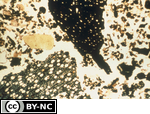Download Image
5.26 MB

ID # 154
Carbonized xylem tissue of stemFrom the Soil Micromorphology Slide Collection
STEM Standard addressed: ESS2E - Biogeology
Appropriate Grade Level(s)
- College-level
- Classroom Lectures
- Laboratory Activities
- Soil Microbiology
Data for 35-mm slide
Micromorphological description of slide: Fragment of carbonized xylem tissue of a plant root occurring as a discrete organic body in the soil.
Data for the horizon Horizon sampled: Ahl Depth sampled: 0-18 cm
Physical and chemical data available: pH = 7.2; oc = 5.0%; N = 0.31%; TEC (cmol ( +)/kg) = 20; total clay = 12%, fine clay = 7%; clay mineralogy = smectite > mica > kaolinite.
Macromorphological description of horizon: Ah1 (0-18 cm): Black (1O YR 1.7/1 m); sandy loam; weak to moderate fine granular; very friable; abundant fine and very fine random, plentiful medium oblique roots; clear wavy boundary; 12-20 cm thick.
Micromorphological description of horizon: The Ah horizon has an iunctic granic/granoidic intergrade f-fabric with a weak chlamydic component. Dominantly fine (50-150 µm) discrete and partially coalesced organic and mull units loosely fill spaces between large f-members dominantly comprised of mineral grains and to a much lesser extent decomposed organic tissue. Mineral grains have partial coatings of organic and mull-like plasma. Numerous large (5 mm diameter) isotubules and aggrotubules filled with discrete (1.0-1.5 mm) and strongly welded earthworm casts occur near the surface. Earthworm casts contain small humigranic units, occasionally fecal pellets of micro arthropods, and rarely zones of biogenic micro crystals of calcite. Fecal pellets of small Diptera (fly) larvae (90-225 µm) occur as weakly welded clusters in voids; fecal pellets of mites (35-70 µm) commonly occur in decomposing plant tissue; and fecal pellets of Enchytraeids (potworms) (90-120 µm) occur in aggrotubules. Aragonite crystal sheets are evident in decomposing plant tissue.
Data for thin section
Preparation of sample: Air dry Impregnating medium:
Epoxy Thickness of section: 30 µm
Orientation of section: Vertical
Soil Classification U.S.: Cryoboralf
F.A.O.: Chernozem
Canada: Orthic Black Chernozemic
Elevation: 795 m
Topography and hill slope position: Rolling slope crest Parent material: glacial/fluvial
Soil climatic data and/or soil water balance: Subhumid moisture regime and cold soil temperature class
Vegetation: Trembling aspen (Populus tremuloides) parkland
Micromorphological description of slide: Fragment of carbonized xylem tissue of a plant root occurring as a discrete organic body in the soil.
Data for the horizon Horizon sampled: Ahl Depth sampled: 0-18 cm
Physical and chemical data available: pH = 7.2; oc = 5.0%; N = 0.31%; TEC (cmol ( +)/kg) = 20; total clay = 12%, fine clay = 7%; clay mineralogy = smectite > mica > kaolinite.
Macromorphological description of horizon: Ah1 (0-18 cm): Black (1O YR 1.7/1 m); sandy loam; weak to moderate fine granular; very friable; abundant fine and very fine random, plentiful medium oblique roots; clear wavy boundary; 12-20 cm thick.
Micromorphological description of horizon: The Ah horizon has an iunctic granic/granoidic intergrade f-fabric with a weak chlamydic component. Dominantly fine (50-150 µm) discrete and partially coalesced organic and mull units loosely fill spaces between large f-members dominantly comprised of mineral grains and to a much lesser extent decomposed organic tissue. Mineral grains have partial coatings of organic and mull-like plasma. Numerous large (5 mm diameter) isotubules and aggrotubules filled with discrete (1.0-1.5 mm) and strongly welded earthworm casts occur near the surface. Earthworm casts contain small humigranic units, occasionally fecal pellets of micro arthropods, and rarely zones of biogenic micro crystals of calcite. Fecal pellets of small Diptera (fly) larvae (90-225 µm) occur as weakly welded clusters in voids; fecal pellets of mites (35-70 µm) commonly occur in decomposing plant tissue; and fecal pellets of Enchytraeids (potworms) (90-120 µm) occur in aggrotubules. Aragonite crystal sheets are evident in decomposing plant tissue.
Data for thin section
Preparation of sample: Air dry Impregnating medium:
Epoxy Thickness of section: 30 µm
Orientation of section: Vertical
Soil Classification U.S.: Cryoboralf
F.A.O.: Chernozem
Canada: Orthic Black Chernozemic
Elevation: 795 m
Topography and hill slope position: Rolling slope crest Parent material: glacial/fluvial
Soil climatic data and/or soil water balance: Subhumid moisture regime and cold soil temperature class
Vegetation: Trembling aspen (Populus tremuloides) parkland
Method
Frame length: 3.5 mm
Light mode: Partially polarized
Light mode: Partially polarized
References
Source: S. Pawluk
Peer Review: Yes
Credit this item to: SSSAMedia Date: 1993-01-01
Provided By: (SSSA) Soil Science Society of America
Author(s)/Creator(s)
-
* Soil Science Society of America
SSSA
Submitted By: (SSSA) Soil Science Society of America
Keywords
- Carbonized xylem
- Ahl
- micromorphology
- Carbonized xylem tissue of stem
Comments
Please login to submit a comment.
Log In to your account
Already a member, certified, or existing customer?*
* Cookies must be accepted to log in.
Not sure if you have an account?
Check Your Email
Join Us!
Connect with members and access the information you need.
Learn more.
Ready to Join?
If you have an account, login on the left. Not sure if you have an account or need to create one? Check your email with the link above. We look forward to welcoming you.